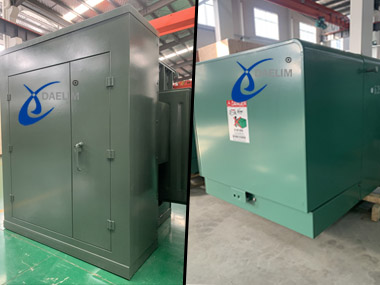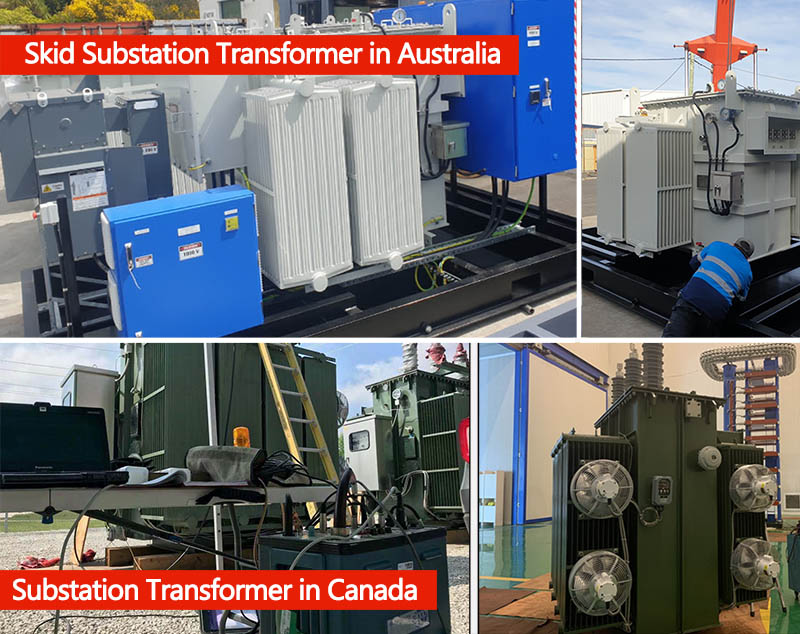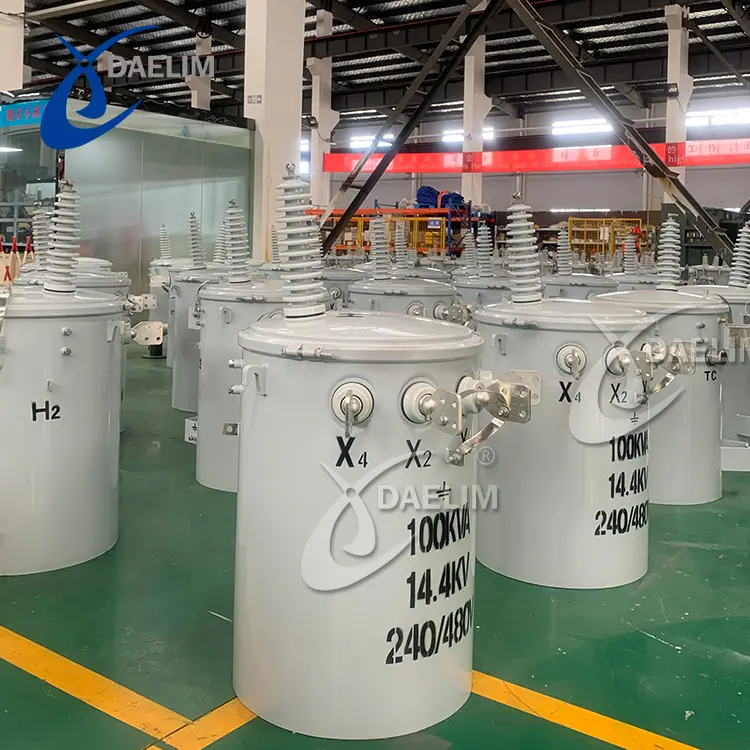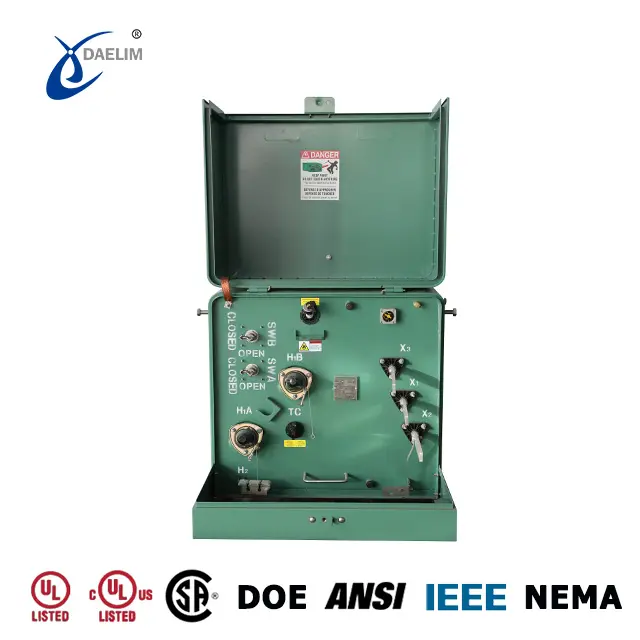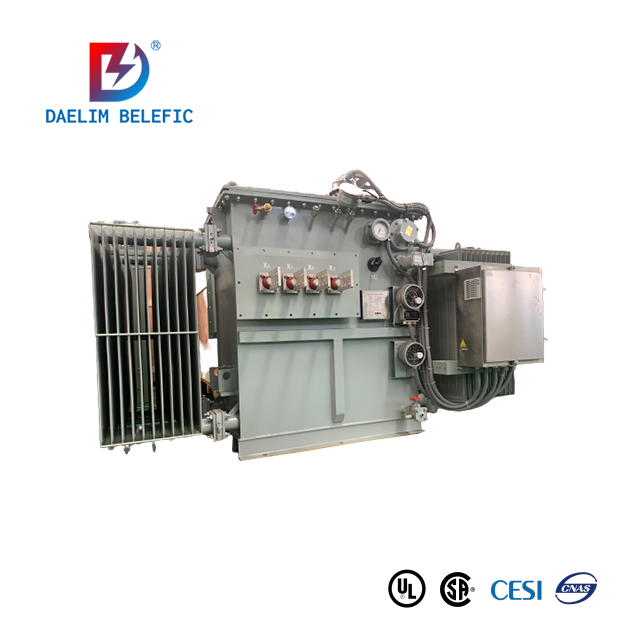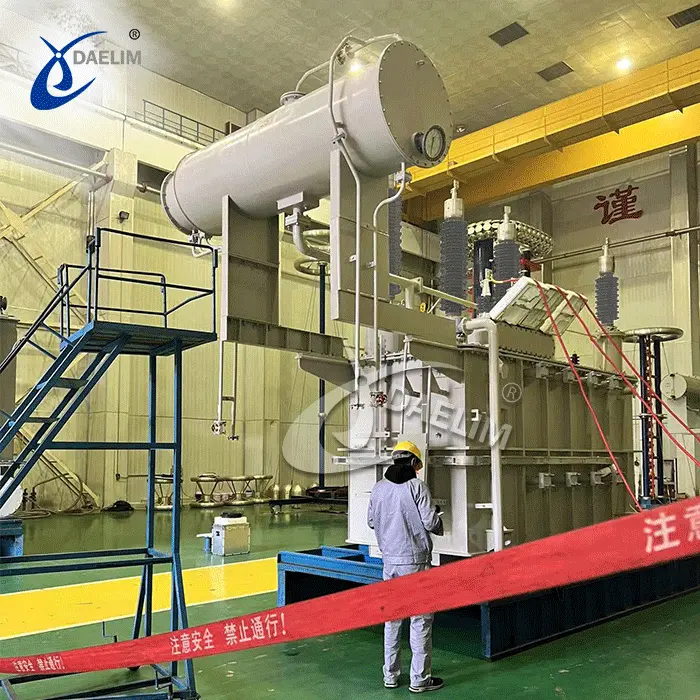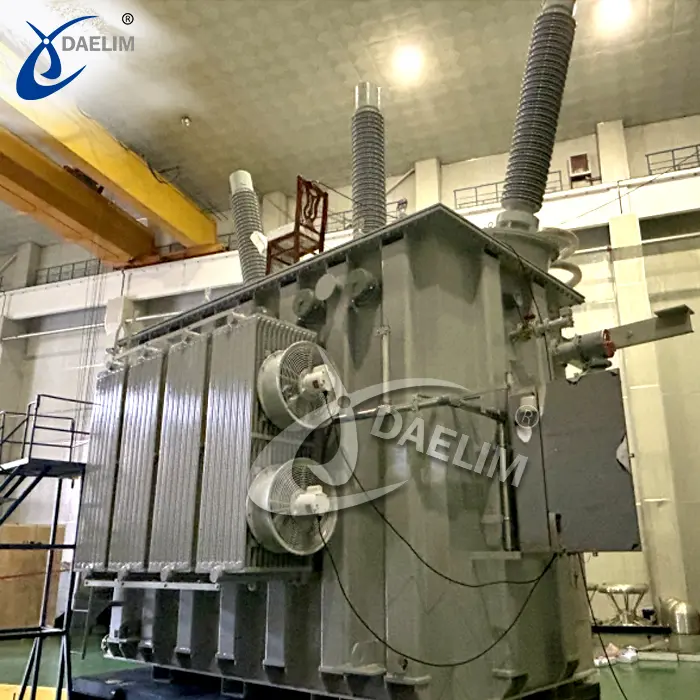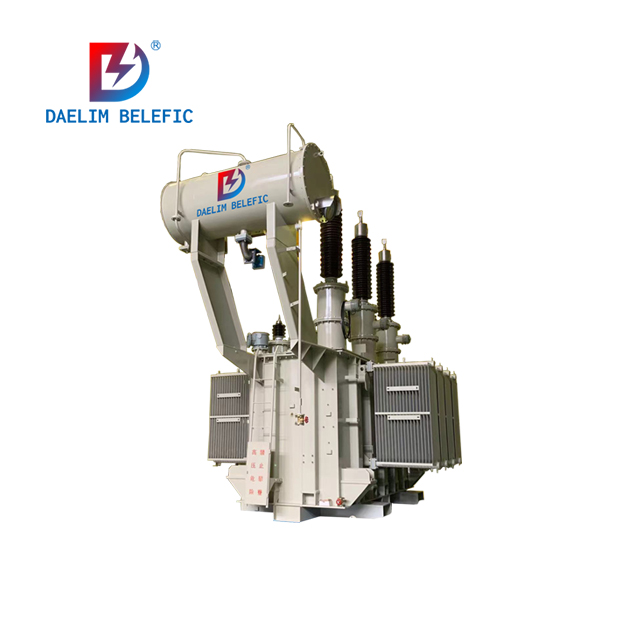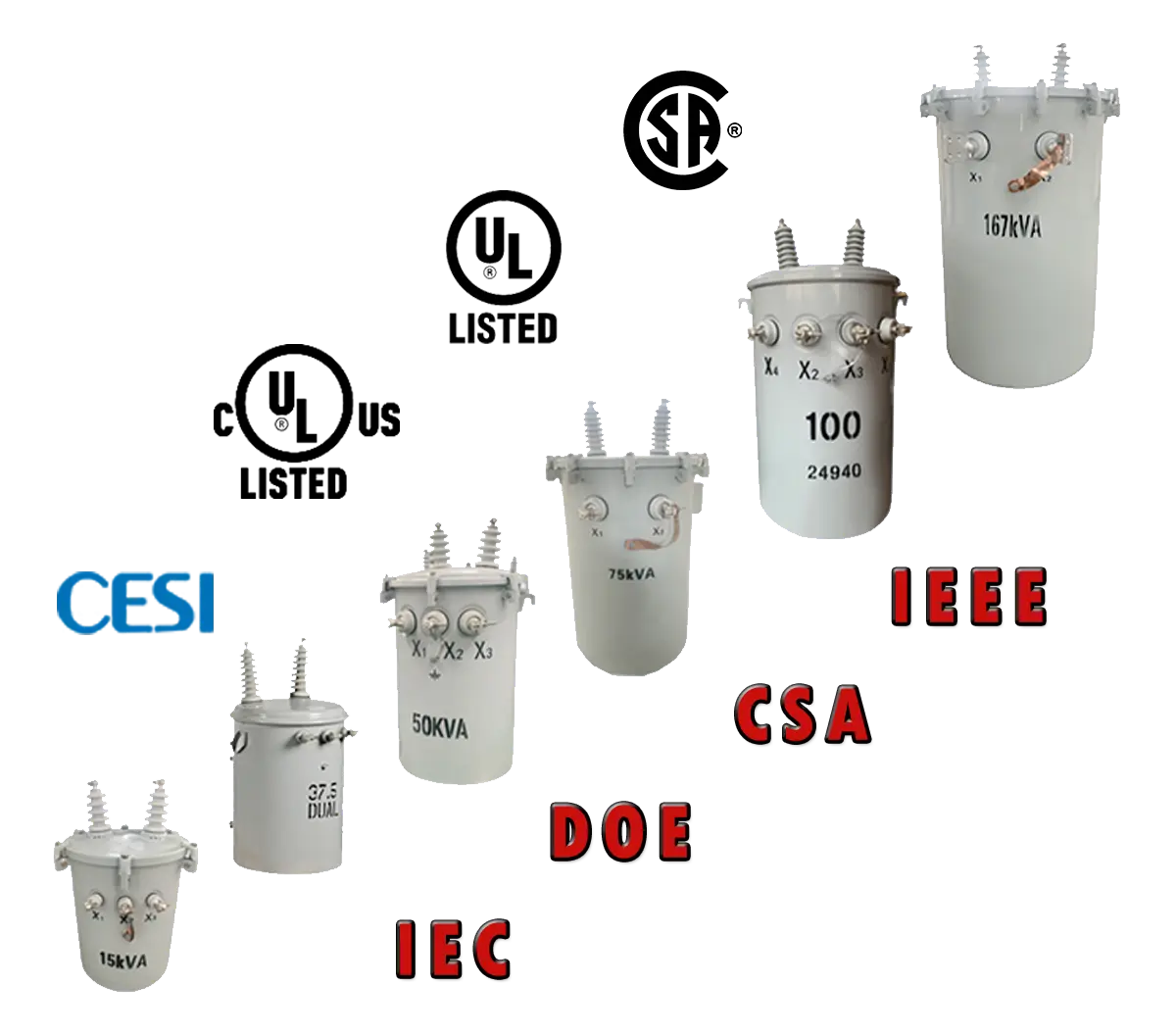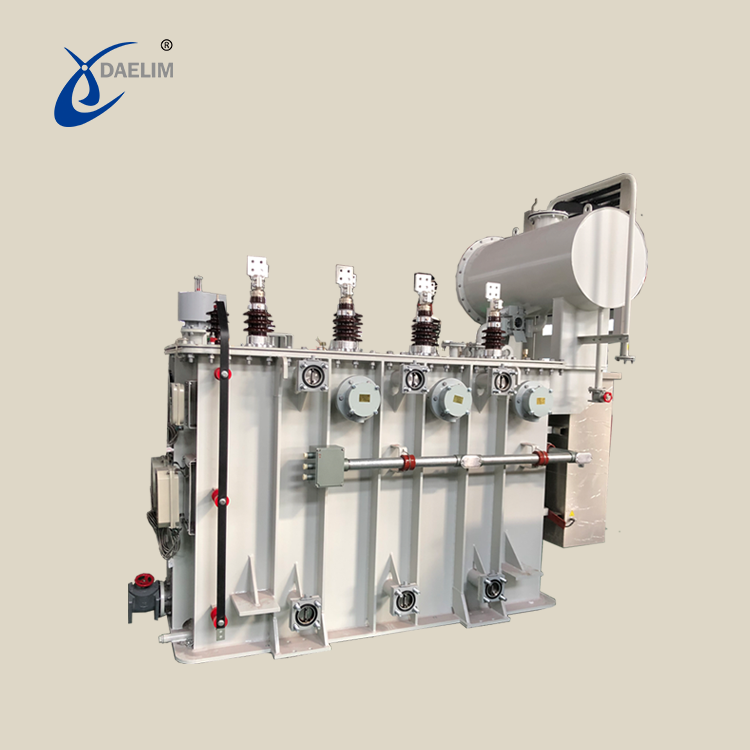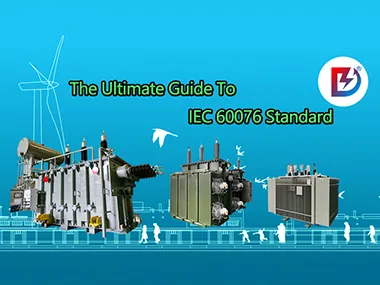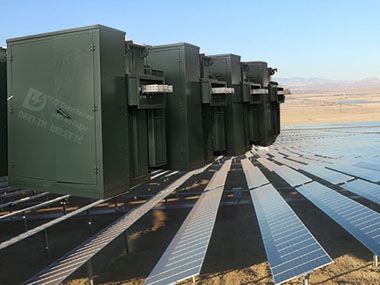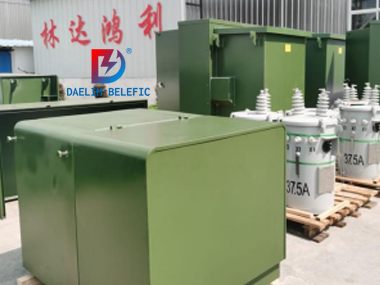Ultimate Guide To Oil Filled Transformer
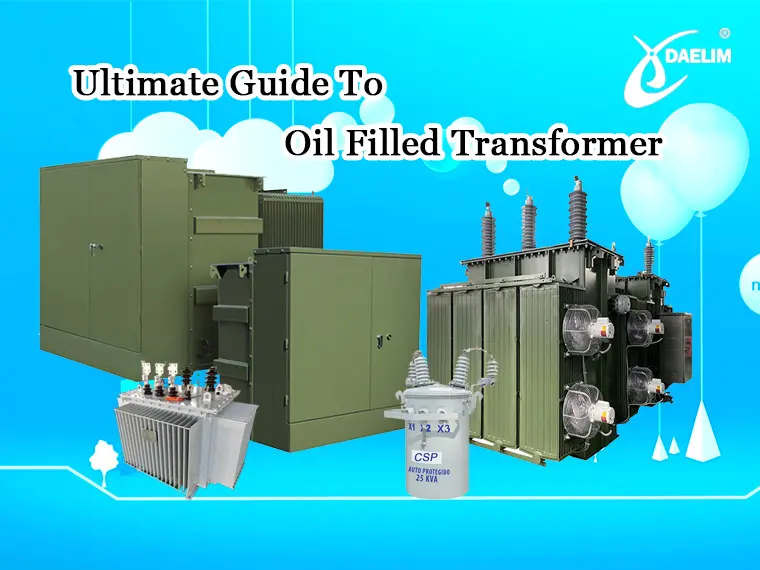
Oil filled transformer is a type of electrical transformer that uses a liquid, such as oil, as a cooling and insulating medium. Therefore, it is also called a liquid transformer. The use of liquid provides better heat dissipation compared to dry transformers, allowing for a higher power rating and increased efficiency.
When a transformer uses oil as an insulating medium, this type of device is known as an liquid filled transformer. These liquid filled transformer use mineral oil or vegetable oil as insulation and cooling medium.
Some of the remarkable oil filled transformer manufacturers globally are ABB and Daelim. They produce a massive insulation class of oil type transformer to satisfy every client's needs.
Contact Daelim TransformerOil-filled transformers are a type of electrical transformer that uses oil as both a cooling and insulating medium. They are commonly used in high-voltage power transmission and distribution systems, as well as in industrial and commercial applications. The use of oil provides better heat dissipation compared to air-cooled transformers, allowing for a higher power rating and increased efficiency. Additionally, oil provides good dielectric insulation and helps to prevent the corrosion of internal components. However, oil-filled transformers require regular maintenance and may pose an environmental hazard in the case of oil leaks or spills.
Related Article
The Ultimate FAQs Guide To Oil Type Transformer
Oil Filled Transformer Manufacturers
There are many manufacturers of oil-filled transformers worldwide. Some of the leading companies in the industry include:
- Daelim Transformers
- ABB
- Siemens AG
- General Electric (GE)
- Schneider Electric
- Crompton Greaves
- Bharat Heavy Electricals Limited (BHEL)
- TBEA Energy (India) Limited
- Mitsubishi Electric
- CG Power and Industrial Solutions Limited
- JSC "Concern Energomera"
These companies offer a wide range of oil-filled transformers for different applications and voltages. It is important to choose a reputable and experienced manufacturer that can provide high-quality products and reliable customer support.
Learn more:
Power Transformer Manufacturers Around the World
What Is Liquid-Filled Transformer?
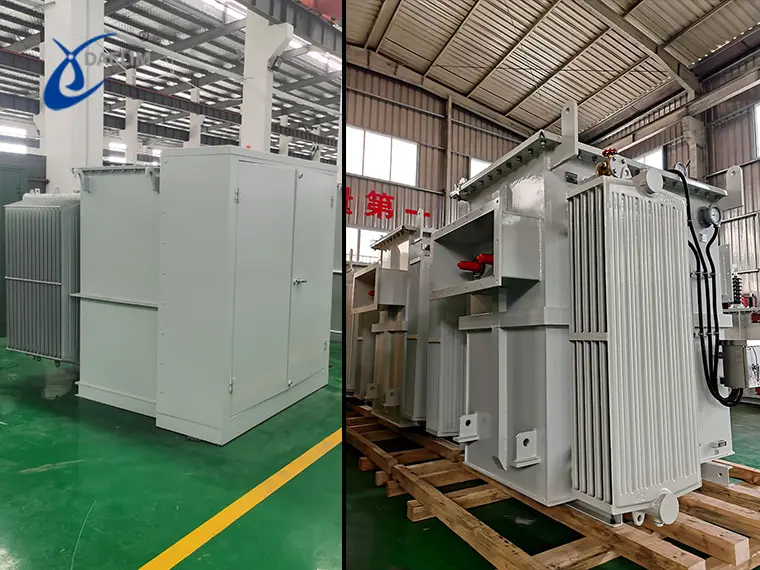
A transformer with liquid-filled insulation is a transformer in which the insulating material is a dielectric fluid that does not solidify under normal conditions. Such transformers are used for high-voltage or extra-high voltage applications where dry ambient conditions would cause oil immersion transformers and other wet-type units to leak oil. This is the most common type of transformer used in power grids.
Transformer oil is normally hard and mineral-based which can solidify at low temperatures. This can lead to a transformer dropping out output voltage due to the transformer coils' inability to move freely. The alternative to an oil-filled transformer is a dry type unit that has no water or oil base medium, so it would not be affected by ambient temperatures.
Get it now:Transmission Transformer
What Is Oil-Filled Transformer Used For?
Oil-filled transformers are used in a variety of different applications for both residential and commercial environments. Oil-filled transformers are used to provide power to electrical systems in residences, offices, and various industrial centers.
This power is provided by either an engine or a generator; the transformer allows electricity to flow through it efficiently without damaging the wire. Electricity generated by oil-filled transformers can also be transferred with other equipment over long distances; this allows an area not serviced by wires or generators to be able to receive electricity without extensive construction projects that take time and money. When used with diesel engines or generators, this process is referred to as "diesel powered electrical generation".
Liquid Filled Transformer Types
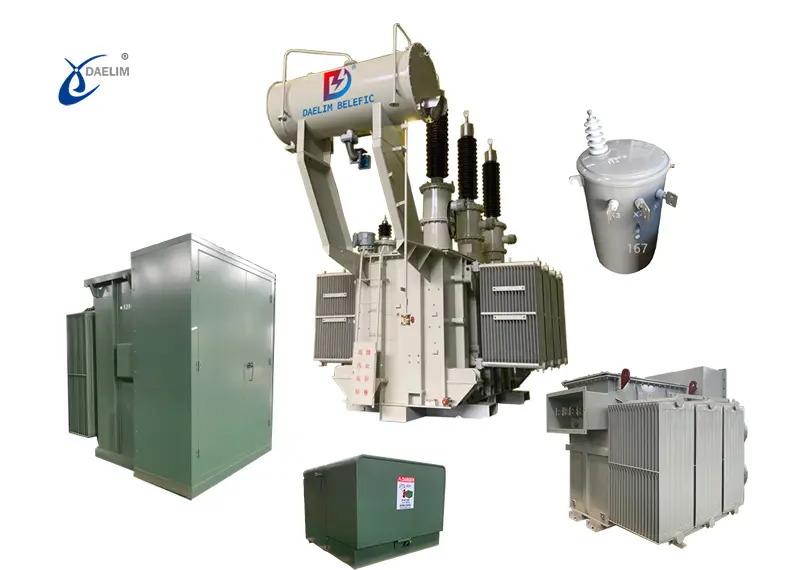
The first liquid-filled transformer type is called the pot core. This is the oldest type and it has a relatively low power rating. These are used mostly at voltages of less than 5kV, as higher voltages present a significant risk of overheating which can cause a fire. The next liquid filled transformer type is called the toroidal core and this can be easily identified by its doughnut shape. This was invented in 1956 by two engineers named Leon Elsliger and Phillip Lorden in response to the limitations of pot cores that resulted from having to wrap wires around them for cooling purposes. The idea was to use the full volume of the core and loop the wires over it. This allows for air cooling and the possibility of adjusting the core temperature by adding more or less air.
The next type is called a finned core, which is similar to toroidal cores but with a significantly different layout. The primary difference is that they are shaped like rings and have fins in between them around the circumference that form an annular shape also showing thru from one side to another. These cores were invented in 1961 by two engineers named Frank Frazier and Max Makowski as an improvement over toroidal cores for higher voltages like 50kV and 100kV. These cores are used in transformers with voltages between 100kV and 200kV and for higher power ratings like 200kW and 300kW.
The next liquid filled transformer is the mylar core. This is a very new type of transformer and it was invented in 2005 by a German physicist named Artur Stremmel. It was patented by Dr. Stremmel and the name for it was coined by electrical engineer Heiko Zander after observing Dr. Stremmel conduct research on the construction of this type of core. The core uses polyester film to house the tape wound wires instead of a metal ring as in previous types. The primary difference in performance is that mylar cores are more efficient than the previous types while being much lighter. They also produce less electrical noise than other types of core. The advantage of using mylar cores is that they can be manufactured at a very low cost as compared to using other core materials like copper or PET film. This allows them to be used at a much lower cost in applications that would otherwise not allow the use of lead-free materials such as those found in most transformer designs.
The next liquid filled transformer type is called the ISO shell and it was invented by a Serbian electrical engineer named Dragan Krivokapic.
Related Article
How Much You Know For The Different Types Of Transformers?
Oil Filled Transformer Ratings
Oil filled Transformers are a type of transformers that have oil immersed in the core. There are many advantages to this type of transformer. The oil offers thermal and mechanical insulation and it can effectively compensate for power factor distortion or power loss, turning all electrical energy into mechanical energy. When choosing an oil-filled transformer manufacturer you should note that there is a wide variety of types of transformers to choose from and some manufacturers offer more than one model in their product line, each with its own benefits.
These transformers are used for applications such as industrial motors, rotating machines, pumps, compressors, and generators.
Oil filled transformers are designed to work at a certain maximum voltage. They are available in voltages up to 500kV and ratings up to 1000MVA. On average, oil-filled transformers can handle 3.5% to 5% loss without any noticeable alteration in the performance of the device. This is a result of the fact that oil does not have any inductance or resistance and is actually close to having zero reactance. This can also compensate for power factor distortion or power loss in a circuit.
The oil in the transformer is filled with a mixture of mineral oil and lubricating greases. Depending on the particular transformer, the latter may be a silicone-based grease or a lot longer shelf life type. Greases are not cheap so you can expect to pay about $3 for 250ml of mineral oil and another $1 for 100ml of silicone grease.
The data sheets from some manufacturers show the minimum voltage that can be handled by their transformers. This range is usually shown on each item's specification sheet or in the manufacturer's literature. Usually, this voltage must be reached with a loss (power factor distortion) of no more than 0.5% to maintain proper operation. At this level, the transformer will still have proper insulation and sufficient loss to work safely at its rated voltage. This can be used to determine what rating transformer to buy. For example, if you need a 2800V transformer with a loss of no more than 0.5%, the power (Voltage x Current) must be less than 80kVA.
They are usually used in applications where you want to convert other forms of energy into electrical energy and make use of it in another form as well.
You may enjoy: The Ultimate Guide To 30 MVA Transformer
Are All Transformers Oil-Filled?
No, not all transformers are oil-filled. Transformers can be classified into two main categories based on their cooling medium: air-cooled and liquid-cooled (oil-filled).
Air-cooled transformers use air as the cooling medium and do not contain oil. They are typically used in low-voltage and medium-voltage applications where the power rating is lower, and the risk of fire is minimal.
Liquid-cooled (oil-filled) transformers use oil as the cooling and insulating medium. They are commonly used in high-voltage power transmission and distribution systems, as well as in industrial and commercial applications, where a higher power rating and increased efficiency is required.
So, not all transformers are oil-filled. The choice of cooling medium depends on the specific application and requirements of the transformer.
Wet Transformer
A wet transformer is a type of electrical transformer that uses a liquid, typically oil, as an insulating and cooling medium. The liquid is stored in an internal tank and circulates around the transformer's windings to dissipate heat and improve cooling. Wet transformers are commonly used in high-voltage power transmission and distribution systems, as well as in industrial and commercial applications, where a higher power rating and increased efficiency are required. The use of liquid insulation allows for a larger power density than air-cooled transformers and provides improved protection against corrosion and arcing. However, wet transformers require regular maintenance, and the liquid used in the transformer may pose an environmental hazard in the case of leaks or spills.
Try for free: 3 Phase Pad Mounted Transformer
What Happens If A Transformer Runs Out Of Oil?
- The phenomenon of oil leakage not only seriously affects the appearance but also causes economic losses due to the transformer needing to be suspended and excluded.
- Oil leakage will seriously interfere with the monitoring and judgment of the alarm status and the correctness of the instructions regarding the oil level in the transformer storage cabinet.
- After the leakage is reduced, it may cause the charged joint switch to run under the condition of no oil insulating, which may cause a breakdown, short circuit, burning, and even cause equipment explosion.
- After the transformer leaks the oil, it will cause the full seal transformer to lose the sealing state, which will easily cause the invasion of the outside air and water to reduce the insulation performance. The aging of the insulation will affect the safe, reliable operation and service life of the transformer.
Therefore, once the transformer leaks oil, it must be inspected and maintained in time.
What Are The Steps To Keep An Oil-Filled Transformer Running Smoothly?
You can take these precautionary steps to keep your oil filled transformer
running smoothly.
Step 1. To isolate the low-voltage side of the oil filled transformer, you'll need to hang a matching nameplate from the draw handle and flip the switch.
Step 2. Make sure the load switch is not connected to the voltage side of the oil filled transformer and the grounding is generally disengaged before turning on the power.
Step 3. Remove the high-voltage knife, and inspect the shell, porcelain, and lead wire with an electroscope.
Step 4. The oil filled transformer porcelain, loss of heat, and cleaning systems all need to be thoroughly checked and maintained regularly.
Step 5. When maintaining an oil filled transformer, it is essential to inspect the voltage side load switch for proper operation and transmission-part lubrication.
Why Are Transformers Placed In Oil-Filled Tanks?
Transformers are placed in oil-filled tanks for several reasons:
- Cooling: The oil provides a means of cooling the transformer, helping to dissipate heat generated by the windings and other components. This allows for a higher power rating and increased efficiency compared to air-cooled transformers.
- Insulation: Oil has good dielectric properties and provides an effective insulating medium for the windings and other components of the transformer.
- Protection against Arcing: The oil helps to prevent arcing, which is a type of electrical discharge that can cause damage to the transformer.
- Protection against Corrosion: The oil provides a barrier between the internal components of the transformer and the external environment, helping to prevent corrosion.
- Reduced Fire Risk: The oil provides a fire-resistant barrier that helps to reduce the risk of fire in the event of a fault.
In summary, the oil-filled tank helps to provide effective cooling, insulation, and protection for the transformer, allowing it to operate at higher power ratings and increased efficiency compared to air-cooled transformers.
Keep reading: Transformer Efficiency
What Is the Difference Between Wet and Dry Transformers?
There are two types of transformers, wet and dry. They both convert voltage, but they do it in different ways - and often have different applications. We will talk about the differences and what applications each type may be best suited for.
The wet transformer is the one you will find more commonly in residential applications and usually has an output from 100 to 1,000 volts. In some cases you can get as high as 4,000 volts for special purposes such as chemical process plants that require higher voltages for heavy machinery.
Read more: Ultimate guide of cast resin dry type transformer
Which Is Better Oil Type or Dry Type Transformer?
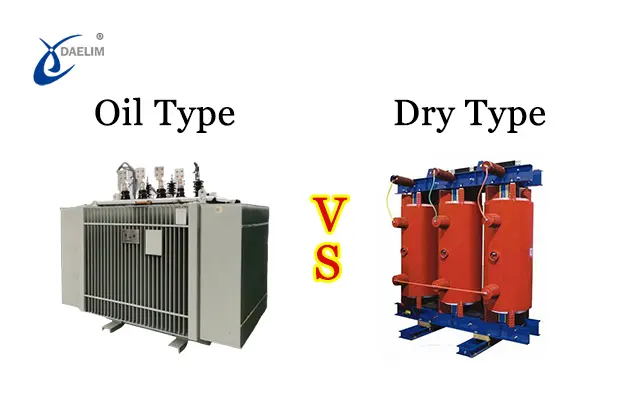
The choice between oil-filled (liquid-cooled) and dry-type (air-cooled) transformers depends on the specific requirements of the application.
Oil-filled transformers are generally more efficient and have a higher power density than dry-type transformers. They are commonly used in high-voltage power transmission and distribution systems, as well as in industrial and commercial applications, where a higher power rating and increased efficiency is required.
Dry-type transformers, on the other hand, are simpler and safer, as they do not contain flammable oil. They are typically used in low-voltage and medium-voltage applications where the risk of fire is minimal and where the required power rating is lower. They are also easier and less expensive to maintain compared to oil-filled transformers.
Both oil-filled and dry-type transformers have their own advantages and disadvantages, and the choice between them depends on the specific requirements of the application, such as the power rating, operating environment, and safety concerns.
Get it now: Dry Transformer: The Ultimate FAQs Guide
What Are The Benefits Of Acquiring Oil Transformers?
These are some of the benefits you will achieve when you purchase
oil transformers.
- Oil transformers are widely utilized in power distribution systems.
- Commercial and industrial settings benefit greatly from the use of step-down oil transformers.
- The power amplifier of oil transformers functions admirably.
- Oil transformers may be highly utilized practically anywhere because of their protective coating.
- Even if the electrical grid collapses, oil-cooled distribution transformers can continue to supply electricity to homes and businesses.
- Oil transformers that experience an unexpected failure can be essentially diagnosed and repaired rather than thrown away, resulting in greater efficiency with less maintenance.
Overall, taking oil transformers to a nearby independent service repair facility will yield the best repair results at the lowest total cost.
What Are The Disadvantages Of Purchasing Oil Type Transformer?
These are some of the major disadvantages to consider when you're planning on purchasing an oil type transformer.
- A major drawback for oil type transformer is the oil's flammability and explosive potential, which cancels out its ability to dissipate heat.
- Many oil type transformer require additional vertical space outside of enclosed substations to accommodate oil tanks.
- An oil type transformer installation has strict requirements for its physical layout.
- To function properly, oil-type transformers need a lot of room around them.
- Strict safety standards apply to the placement of an oil transformer within a building.
- It's far more costly to install an oil-type transformer in a substation.
We have learned that dry transformers and oil-filled transformers have significant importance as well as potential drawbacks. That's why it's important to think about where the transformer will be generally applied before buying it.
3000 kVA Oil Filled Transformer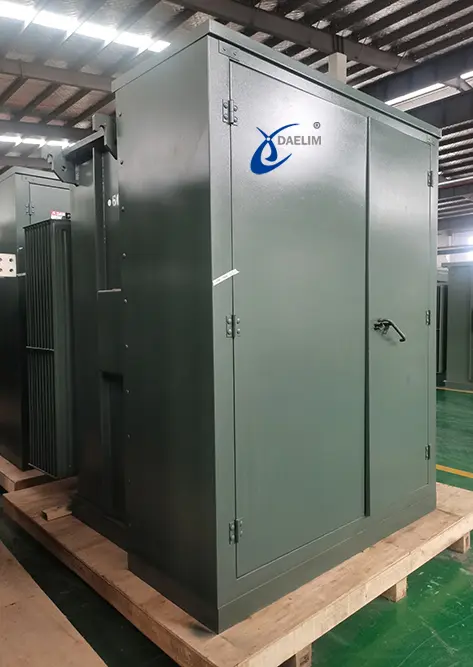
A 3000 kVA oil-filled transformer is a large liquid-cooled transformer used in high-voltage power transmission and distribution systems, as well as in industrial and commercial applications. This type of transformer typically uses oil as the cooling and insulating medium, which helps to dissipate heat generated by the windings and other components and provides effective insulation for the electrical components.
A 3000 kVA oil-filled transformer is capable of handling a large amount of power, making it suitable for high-demand applications. However, it also requires regular maintenance and monitoring, such as oil sampling and testing, visual inspections, and monitoring of temperature and pressure, to ensure its safe and reliable operation.
It is important to choose a transformer that is specifically designed and rated for the required voltage and power levels, as well as for the operating conditions, such as temperature, humidity, and environmental hazards. It is also important to have trained personnel perform the installation and maintenance of the transformer.
Daelim Transformer offers two variants of 3000 kVA transformers: a 3000 kVA pad-mounted transformer and a 3000 kVA substation transformer.
Try for free: How To Purchase 3000kVA Transformer In USA & Canada?
What Exactly Is A Liquid Filled Transformer?
A liquid-filled transformer uses oil as the insulating medium.
To reduce the utility voltage, oil filled transformer are frequently applied in tandem with other incoming or outgoing devices.
In most cases, liquid filled transformer are mainly used everywhere from mines and factories to shipping and factories.
The oil filled transformer's technical and engineering components have been highly constructed to withstand severe conditions while still functioning reliably.
Oil filled transformers can be usually operated indoors if placed in a vault, but mineral oil is the most common liquid for exterior use in liquid filled transformers.
What Are The Applications Of Liquid Filled Transformer?
Liquid filled transformer is perfect for a myriad of business and manufacturing uses.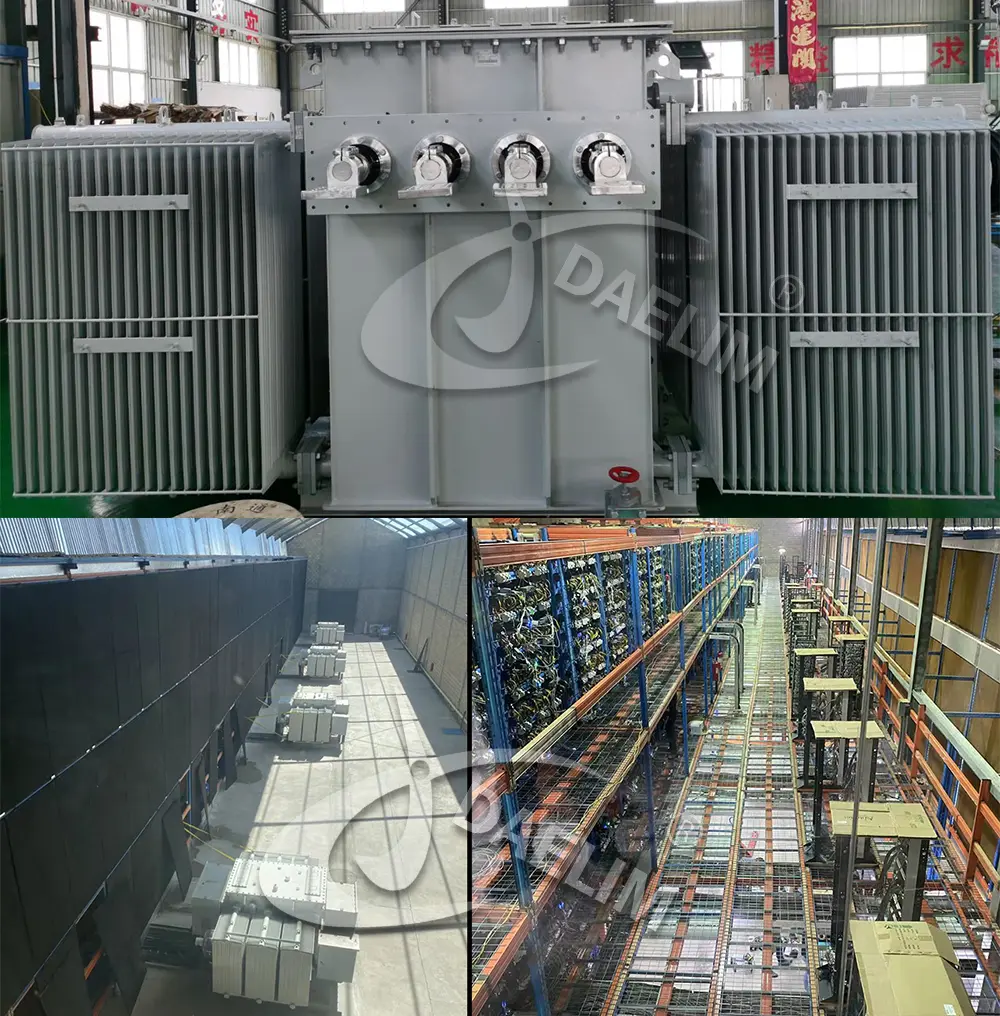
- Blockchain
- Data Center
- Steel Mills
- Oil & Gas Plant
- Utilities
- Renewable Energy
Check Daelim Transformer Solutions
The most economical solution for outdoor use usually involves the application of an oil filled transformer.
As you can see, liquid filled transformer are more efficient than their dry-type counterparts, especially when the working voltage is low and when the transformer is large.
Liquid filled transformer not only have the capacity to handle more power but also have higher voltage ratings than their dry-type counterparts.
You may enjoy: How much do you know about oil-immersed distribution transformers?
What Type Of Liquid Is Inside An Liquid Filled Transformer?
Mineral oil and vegetable oil is the liquid for liquid filled transformer.
However other formulations with improved engineering or environmental features are gaining ground.
Mineral oil in liquid filled transformer is special because it maintains its insulating characteristics even at very high temperatures.
An liquid filled transformer is extensively used in LED lighting, voltage-sensitive capacitors, and actuators.
They serve as an insulating material and reduce overheating and damp emissions. In addition to that, the dielectric strength of mineral oil is exceptionally high.
In order to pass the dielectric strength test included in an oil filled transformer, the oil must withstand 30 KV for 1 minute at a spacing of 2.5 mm.
In an oil filled transformer, the mineral oil serves to regulate the temperature of the copper wiring.
Why Do We Use Oil Inside An Liquid Filled Transformer?
The primary functions of transformer oil in an liquid filled transformer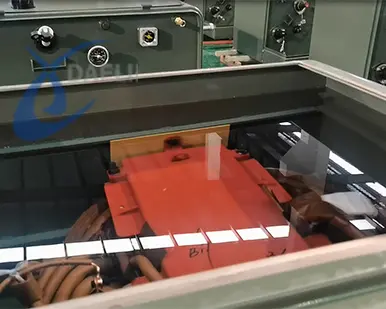 is to act as an insulator and a coolant.
is to act as an insulator and a coolant.
This requires it to keep its chemical stability, thermal conductivity, and dielectric strength despite subjecting to high temperatures for an extended period.
Insulating Material: One of the most fundamental insulators is oil. Their dielectric capacity surpasses that of air.
Oil's strong dielectric strength implies it won't conduct electricity away from a circuit under high voltage.
Arc Resistance: If an arc is generally formed owing to a tiny defect, such as an inter-turn short circuit), the oil in the liquid filled transformer will extinguish it.
Cooling Source: Mineral oil is the primary medium for the cooling process. When the oil in the radiators of the liquid filled transformer
grows hot, the fluid is then recirculated throughout the system.
A transformer's rating is always determined in large part by its cooling system.
Damping: When a transformer is merely subjected to a pulsating magnetic field, a phenomenon known as magnetostriction causes the core to vibrate.
Lubrication: The only moving component of the liquid filled transformer
is the OLTC (On Load Tap Changer), which must be highly lubricated.
Contamination Detection: The transformer's oil can be mainly utilized as a detector for contamination.
As the oil moves through the liquid filled transformer it gathers up particles and pollutants that might serve as early warning signs of failure.
Try for free: The Ultimate Guide to Oil Cooled Transformers
Why Do Oil Cooled Distribution Transformers Need Oil?
Simply put, it's a cooling mechanism for oil cooled distribution transformers. Oil is progressively pumped into oil cooled distribution transformers while still under vacuum, saturating the paper and filling any spaces.
Oil temperature indicators indicate the transformer's internal state, revealing the presence or absence of a short circuit. In addition to that, oil cooled distribution transformers provide an extraordinarily high level of protection against the occurrence of a failure that could have disastrous consequences.
Therefore, oil-cooled distribution transformers will be given major preference in situations where there is concern about the availability of space. To be effective as an electrical insulator, transformer oil must be in pristine condition.
Are Oil Filled Transformer Safe Nowadays?
Yes, oil filled transformer are safer nowadays.
Some of the non-combustible liquids that oil filled transformer use are the following.
- silicone
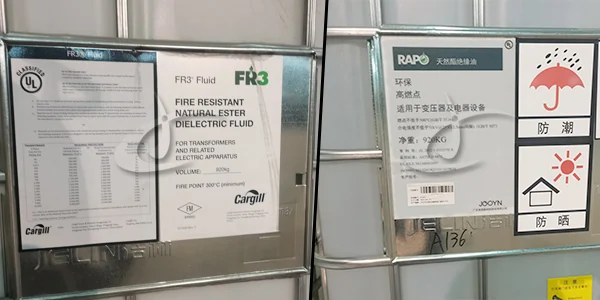
- elevated temperature hydrocarbons
- gas-perchloroethylene
- oil-based HMWH blends
These fluids are both safe for the environment and resistant to fire.
Biodegradable oil filled transformer apply environmentally preferable materials like animal fats and vegetable oils in place of petroleum oils, and the liquids oil with ul certificate.
Because of their lesser combustibility, they contain the dielectric substances mentioned above.
Since oil filled transformer started as a non-toxic substances, they can absorb more of their surroundings.
Overall, oil filled transformer features a high absorption rate in the environment and are less likely to catch fire.
How Does An Oil Immersed Transformer Differ From A Dry Type One?
Let's identify the differences between oil immersed transformer
and dry type transformer.
Cooling Source
The cooling source of the dry transformer relies mainly upon the air.
At the same time, an oil filled transformer cooling source is mainly oil.
Dry transformers come from the fact that there is no oil inside of them.
Oil is necessary for oil cooled distribution transformers because it acts as an insulator for power current.
Efficiency
Dry-type transformers are inefficient due to space and voltage limitations.
Therefore, oil immersed transformer are more efficient in terms of electrical losses and maintenance operation.
Maintenance
Oil immersed transformer necessitate regular oil quality checks, which are unnecessary for dry types.
Dry transformers are smaller in size because there is no need for a tank.
Oil is also susceptible to environmental and climatic changes, but dry transformers are not.
Application
When oil leakage poses a significant concern in an outdoor setting or inside a building, dry-type transformers are the safest option.
They're also common wherever transformer servicing or replacement is going to be easy.
Oil-immersed transformers excel in power transmission and circulation.
Because of its magnitude to keep power, an oil cooled distribution transformers is the equipment of choice when it comes to accomplishing the process of power transmission.
Investment Costs
Dry transformer is more expensive than oil immersed transformer.
Because of their typical energy efficiency, oil immersed transformer
are dependable, durable, and cheap.
The cost of running a dry transformer is higher than that of an oil-immersed one, and they also use more energy.
Recyclable Properties
The core of a dry transformer is more difficult to recycle than the coil of an oil immersed transformer when it approaches the end of its useful life.
Location
Oil cooled distribution transformers are best suitable for outdoor applications.
Meanwhile, a dry type transformer is widely used indoors because of its small carbon impact.
You can find dry transformers in a wide variety of public places since they are completely safe to use.
They are a common feature of workplaces, medical facilities, and recreational areas.
What Are The Safety Precautions When Operating An Oil Cooled Distribution Transformers?
Oil-based transformers require special attention. It is important to know the safety precautions upon operation.
Oil cooled distribution transformers need to have an additional layer of protection against corrosion in order to function properly.
In addition, the range of acceptable temperatures is -40 to +40 deg Celsius, and the maximum allowable wind speed is 355 meters per second.
Anyone working on an oil cooled distribution transformers must wear protective footwear and gloves at all times.
Lastly, oil cooled distribution transformers must prevent a discharge from returning to the source.
Where To Purchase Your Oil Immersed Transformer?
When you're looking for an oil type transformer manufacturer, Daelim is your rightful source.
Daelim's oil immersed transformers can keep your electrical network running smoothly.
Moreover, Daelim is well recognized as a market leader in oil-type transformer manufacturing.
We have both dry and oil-cooled distribution transformers, so you can pick the one that works best for you.
Additionally, Daelim offers their clients proper tutorials on oil filled transformer which include maintenance, repair, and installation.
Overall, Daelim's oil filled transformers are user-friendly, and they may be highly modified in a variety of ways to fulfill the specific requirements of each client.
What Are The Differences Between Transformer Oil And Other Types Of Oil?
Oil filled transformer require a special kind of oil called transformer oil or insulating oil.
For an oil filled transformer to function correctly, it is necessary to fill it with oil due to the insulating and cooling properties that oil possesses.
Among the many distinctions that set transformer oil apart from other oils are the following:
Dielectric Power
As a result of the high dielectric value it possesses, transformer oil serves as an insulator and stops leaks.
Due to the enormous electrical voltage that the oil-filled transformer needs to be able to sustain, this is necessary for the device to function properly.
Quality
Because transformer oil is chemical and thermally resistant, it does not degrade over time.
Viscosity
Because low-viscosity oil can cause poor heat transfer and high-viscosity oil can increase power loss, the consistency of transformer oil is closely monitored.
Purification
To prevent damage to the oil-filled transformer and maintain the oil's insulating characteristics, it must be thoroughly cleaned.
Reading more: What is the difference between mineral oil and vegetable oil?
Are Oil-Cooled Distribution Transformers More Efficient?
Oil cooled distribution transformers perform better than their dry counterparts in terms of efficiency.
When operated at higher voltages, they consume less energy and take up less room.
Dry transformers frequently experience the issue of overheating, which in turn leads to increased electrical losses.
At the same time, it can cause the owner to increase expenses associated with maintenance and repairs.
Oil cooled distribution transformers are the most space-efficient option since they can be mainly manufactured to any size.
While dry type cast resin distribution transformers are generally limited in size by the cast resin molding process.
Even if you heat it for long periods, the oil in oil-cooled distribution transformers maintains its dielectric qualities and chemical consistency.
What Types of Oil Are Not Suitable For Oil Filled Transformer?
Other oils, such as lubricating oil or motor oil, are mainly designed to serve a specific function.
These come equipped with their own special set of characteristics as a result of the formulation process.
Keep in mind that some oils should not be generally used in oil-filled transformers due to the lower levels of stability and insulation that they offer.
What Are The Reasons For The Reconditioning The Oil In Oil Immersed Transformers?
Oil needs to be essentially reconditioned after a given amount of time has passed.
Oil cooled distribution transformers go through a variety of transitions during the course of their lifetime. Insulation failures cause oil to become contaminated with solid debris.
In addition, arcing causes massive amounts of gas to be highly released. Some of these gases can dissolve in the oil.
As the oil is usually recycled over and over, it picks up contaminants like water from the air.
This is because of the accumulation of dirt, other pollutants or impurities, and a change in the oil's Ph level.
Therefore, restoring it will make it better at keeping things cool and insulated.
It's also a lot less expensive than completely switching away from oil.
Reading on: Basic Guide To Oil Immersed Transformer
Who Are The Leading Liquid Filled Transformer Manufacturers?
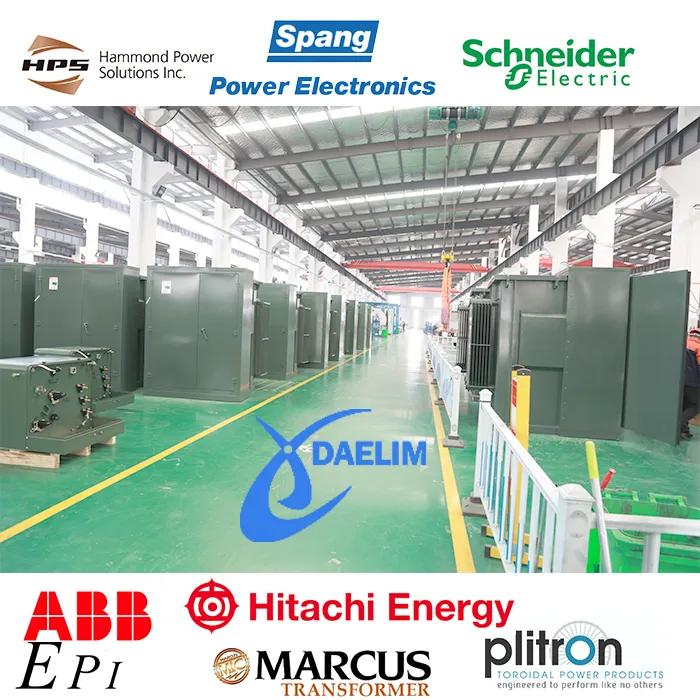 ABB, Siemens, Toshiba, and Daelim Belefic are some of the most reputable names in the liquid filled transformer manufacturing industry.
ABB, Siemens, Toshiba, and Daelim Belefic are some of the most reputable names in the liquid filled transformer manufacturing industry.
ABB Liquid Filled Transformers
A global leader in oil filled transformer manufacturers, ABB collaborates with utilities and manufacturers to boost productivity and reduce waste.
All of ABB's oil filled transformer, loaded with liquid, are highly built to strict international standards.
Using data from its massive worldwide design library, this company creates innovative ABB liquid filled transformers.
A world leader in power and automation solutions, they offer ABB liquid filled transformers to its utility and industrial clients.
Their main goal is to boost productivity while reducing their impact on the environment.
ABB's global manufacturing strategy is generally known as Trafo Star.
This concept represents a standardized set of rules for producing ABB liquid filled transformers and is highly based on core-type technology.
Siemens Liquid Filled Transformers
Siemens Energy is one of the liquid filled transformer manufacturers
that provides two varieties of liquid filled transformer:
- FITformers
- Voltage regulators
These liquid filled transformer are usually applied to transfer electrical energy from higher to lower voltages while keeping the same frequency as before the transformation.
As you can see, the voltage capacity and output levels of large distribution transformers are greater than those of their medium-sized, oil filled transformer counterparts.
To ensure the best possible performance, Siemens uses multiple technologies to create an oil filled transformer.
Toshiba Liquid Filled Transformers
The liquid filled transformer manufactured by Toshiba is dependable and long-lasting electrical equipment.
Toshiba's liquid-filled transformers are commonly used in power plants, transmission lines, and distribution grids.
It's no surprise that Toshiba is one of the top oil filled transformer manufacturers.
In most cases, they receive liquid filled transformer custom orders with power ratings ranging from 100 to 800 KVA.
At the same time, the regular voltage range of oil filled transformer is from 69 to 765 kV.
In-house lab testing at Toshiba ensures the company's products meet the standards for quality, performance, and dependability.
Daelim Liquid Filled Transformers
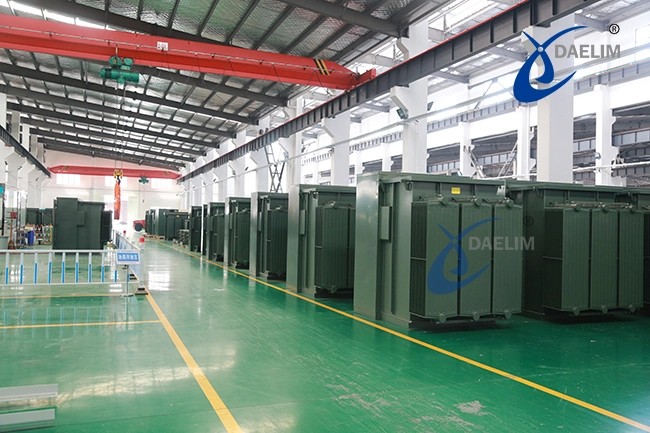 Daelim is a leading liquid filled transformer manufacturer known for their reliable and consistent products.Headquartered in China with a global presence, they produce a variety of liquid filled transformers including pole transformers, pad mounted transformers, small substation transformers, and high voltage power transformers. Their commitment to producing high-quality oil-filled transformers that meet international standards is unwavering.
Daelim is a leading liquid filled transformer manufacturer known for their reliable and consistent products.Headquartered in China with a global presence, they produce a variety of liquid filled transformers including pole transformers, pad mounted transformers, small substation transformers, and high voltage power transformers. Their commitment to producing high-quality oil-filled transformers that meet international standards is unwavering.
With an in-house manufacturing plant and a team of expert engineers, Daelim has the capability to meet all the requirements to build a liquid filled transformer. From design to production and testing, they ensure that every transformer is built to the highest quality standards. Whether you need a standard transformer or a custom solution, Daelim can deliver a reliable and efficient liquid filled transformer that meets your specific requirements.
Learn more about Transformer Manufacturers Around The World
What Is The Insulation Class Of Oil Type Transformer?
It is safe to say that the insulation class of oil type transformer falls under Class-A insulation rating.
This is because you can only use oil filled transformer up to 105 degrees C.
A material's insulation class refers to the highest temperature at which it may continue functioning for the specified time without being potentially destroyed.
Insulation's useful lifespan shifts as temperatures rise and fall.
What Does Flashpoint Temperature Mean In Oil Filled Transformer?
Flash Point temperature, rather than the insulation class, is mainly used to determine the maximum safe oil temperature.
So, the typical flash point of modern oil filled transformer's mineral oil is about 140 degrees F.
Therefore, the temperature needs to be always kept at or above 130 degrees at all times.
Oftentimes, the oil in a transformer can withstand temperatures well over its flash point without losing its performance.
In that case, the insulation class of oil type transformer windings have class-A insulation and is safe to use at 105 deg Celsius.
Get it now: CSP VS Conventional Transformer: Which Is Better?
Why Are Oil Filled Transformer Insulation System Ratings Important?
The importance of oil filled transformer insulation rating is to determine the overload capacity and lifespan of a transformer.
Overload capacities are typically higher in conditions where temperature spikes are moderate.
As the demand for energy efficiency in oil filled transformer increases, insulating system ratings may become a crucial factor in evaluating and acquiring transformers.
Therefore, oil filled transformer manufacturers must consider a variety of criteria when selecting an insulation material for oil filled transformer.
Factors include power output, material cost, and availability.
How Do We Maintain An Oil Filled Transformer?
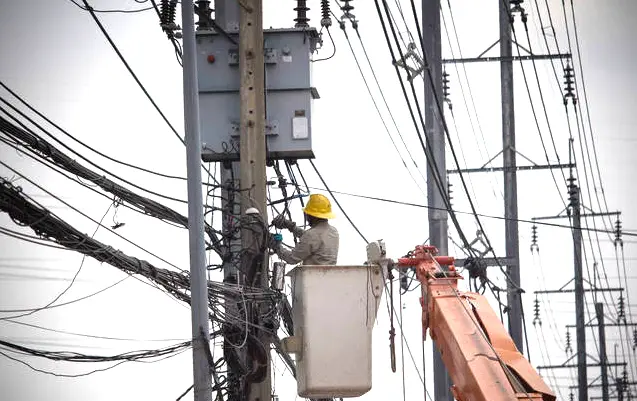
Maintenance of oil-filled transformers is important to ensure their safe and reliable operation. The following are some of the key maintenance tasks that should be performed regularly:
- Oil Level Check: The oil level should be checked regularly to ensure that it is at the correct level and that there are no leaks.
- Oil Sampling and Testing: Samples of the oil should be taken and tested regularly to ensure that its properties are within acceptable limits and that it is not contaminated.
- Visual Inspection: A visual inspection of the transformer and its oil-filled tank should be performed regularly to look for signs of damage, corrosion, or leaks.
- Tightening of Connections: The connections between the transformer and its components should be tightened regularly to ensure that they remain secure.
- Cleaning: The exterior of the transformer and its oil-filled tank should be cleaned regularly to remove any dirt or debris that may have accumulated.
- Monitoring of Temperature and Pressure: The temperature and pressure of the oil in the transformer should be monitored regularly to ensure that they are within acceptable limits.
Regular maintenance of oil-filled transformers is important to ensure their safe and reliable operation and to extend their lifespan. It is important to follow the manufacturer's recommendations and to have trained personnel perform the maintenance tasks.
To ensure the reliability of oil filled transformers, they must undergo routine maintenance.
You should schedule regular maintenance on your transformers to reduce the chance of problems like system breakdown.
Everyday
Oil filled transformer should have their oil levels and operating temperatures checked frequently.
Verify that the environment, the windings, and the oil are all at safe temperatures.
The oil level gauge will rotate when a magnet is mainly placed near it, and the needle will move in reaction to variations in temperature if it is a magnetic model.
If the indicator can't do any of those things, you should get a new one.
Monthly
Get into a habit of testing at predetermined intervals and examining them to determine if you need to filter the oil.
Look for these signs:
- Humidity
- Degradation
- Acidity
- Other elements
Dissolved gas analysis may tell you what kinds of gases are usually dissolved in your oil. You can test this at a lab or on-site.
Annually
Every day, every week, and monthly maintenance duties should take up the majority of your yearly upkeep schedule.
It is important to check the safety relays in the transformer for leakage.
Then next is to check the motorized oil and fan pumps if they have accurate resistance levels.
It is advisable to check for leaks around the pressure relief tank above the transformer every three to five years.
Keep reading: Analysis of electric transformer noise problem
When It Comes To Oil Filled Transformers, What Issues Could Arise?
One of the following is typically a sign that an oil filled transformer
needs maintenance or replacement.
- The insulation's age, for instance, may be indicative of the oil filled transformer's reliability.
- Transformer oil can leak from several different places, including tanks, gaskets, and cooling fins.
- Keep the cooling system of the transformer dry, as water can dissolve mineral deposits. These parts will be difficult to clean because of mineral deposits on their surfaces.
- Oil filled transformer frequently fail because of electrical problems.
- Furans leak out of disintegrating cellulose paper and into the oil, causing the formation of sludge. Airborne pollutants can speed up this process.
Over time, chemicals cause solids to accumulate within the winding structure, leading to the formation of sludge.
Liquid Filled Transformer Manufacturer Daelim
Daelim Transformer always focuses on efficient manufacturing processes with a view to providing customers with standard products at reasonable price points. As a professional international standard transformer supplier such as the ANSI/IEEE, CSA, and AS standards. The pursuit of high -quality and solving customer problems is DB Transformer's unchanged pursuit.
Whether you need Pad Mounted Transformer, Single Phase Transformer, Oil Immersed Distribution Transformer, HV Power Transformer, and Dry Transformer, Daelim can meet all your requirements. Professional sales teams and technical teams will make the entire business communication efficient and concise. You can check your order production status on our website at any time.
Related Products
Related Article
The Ultimate Guide To IEC 60076 Standard
Daelim is IEC, ANSI/IEEE, AS, CSA, and UL transformer manufacturer who has been exported to countries around the world. The transformers supplied by Daelim fully meet and exceed the requirements of the IEC 60076 standard.
Solar Photovoltaic System Solution
DB Transformer serves the world's renewable energy field. Here are solutions for some solar projects provided by Daelim for the United States, Canada, and other countries.
Residential Transformer: The Small Green Electrical Box in the Neighborhood
Daelim residential transformer has UL and CSA certificates. Meet DOE 2016 efficiency value. Daelim Belefic is a Chinese transformer brand and a list of American transformer suppliers. Daelim is a famous professional transformer manufacturer.

